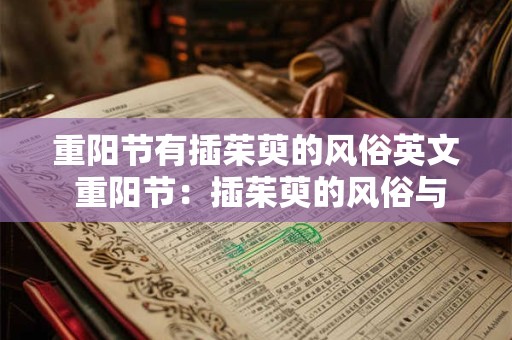In the traditional Chinese calendar, the Double Ninth Festival, also known as Chongyang Festival, is a time for family reunions and paying tribute to the ancestors. Among the many customs and practices of this festival, inserting chrysanthemum leaves, known as ju-yu in Chinese, stands out as a significant cultural symbol.
The Origin of Inserting Chrysanthemum Leaves
The custom of inserting chrysanthemum leaves dates back to ancient times, when it was believed that these leaves could ward off evil spirits and promote longevity. According to folklore, during the Western Han Dynasty (206 BC-9 AD), an official named Liu Yandi, the Yellow Emperor's great-grandson, was so grateful for the chrysanthemum's healing properties that he declared it a sacred plant. Since then, inserting chrysanthum leaves has become a vital part of the Double Ninth Festival celebrations.
The Process of Inserting Chrysanthemum Leaves
On the day of the festival, family members will gather together to prepare the chrysanthemum leaves. First, they will wash the leaves in clean water to remove any impurities. Then, they will select the largest and most vibrant leaves, believing that these will bring the most good fortune. Next, they will attach the leaves to clothing or accessories using string or ribbons. The most common places to attach the leaves are on the chest, shoulders, and head. In some regions, people also wear chrysanthemum leaf crowns or place the leaves in their hair.
The Cultural Significance of Chrysanthemum Leaves
Chrysanthemum leaves have deep cultural significance in China. They symbolize longevity, happiness, and prosperity. In Chinese culture, the chrysanthemum is known as the "flower of longevity" due to its ability to bloom late in the autumn, when other flowers have withered. The leaves are also believed to have medicinal properties that can help boost the immune system and ward off illness.
Another cultural meaning of the chrysanthemum leaves is their association with filial piety. In ancient times, parents would gift their children chrysanthemum leaves as a symbol of love and care. Today, the tradition continues, with family members giving each other chrysanthemum leaves as a gesture of respect and unity.
Chrysanthemum Leaves in Art and Literature
Chrysanthemum leaves have been featured in Chinese art and literature for centuries. In traditional Chinese paintings, the chrysanthemum is often depicted as a symbol of resilience and purity. Poets have also used the chrysanthemum to express themes of beauty, elegance, and the fleeting nature of life. During the Double Ninth Festival, it is customary to enjoy chrysanthemum tea, which is believed to have health benefits and is considered a symbol of happiness.
Chrysanthemum Leaves in Modern Times
Although the practice of inserting chrysanthemum leaves is still widely observed, modern times have brought some changes. In urban areas, many people have shifted from using natural chrysanthemum leaves to buying artificial ones, which are more convenient and easier to care for. However, the cultural significance and the meaning behind the tradition remain unchanged.

Chrysanthemum Leaves and the Double Ninth Festival
The Double Ninth Festival is a time for celebrating family, honoring the ancestors, and appreciating the beauty of nature. Inserting chrysanthemum leaves is just one of the many customs associated with the festival, but it is one that holds a special place in the hearts of many Chinese people. Through this practice, we are reminded of the importance of health, longevity, and filial piety, as well as the rich cultural heritage that binds us together.
In conclusion, the custom of inserting chrysanthemum leaves on the Double Ninth Festival is a testament to the enduring cultural values and traditions of China. It is a symbol of hope, unity, and the appreciation of life, and it continues to be celebrated by millions of people around the world. As we approach this year's festival, let us take a moment to reflect on the beauty of this tradition and the deep-rooted values it represents.
